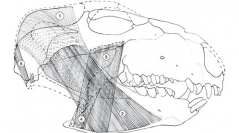

 Geodiversitas
34 (3) - Pages 505-515
Geodiversitas
34 (3) - Pages 505-515Mandible biomechanics analysis cannot take place without the understanding of the development degree and the arrangement pattern of the adductor muscles. In the non mammalian cynodonts, the temporal and the superficial masseter muscles play a primordial role in the lower jaw motion during the food processing. They constitute the key elements of this analysis. Previous studies on non mammalian cynodonts including Dadadon isaloi Flynn, Parrish, Rakotosamimanana, Simpson & Wyss, 1999 and Menadon besairiei Flynn, Parrish, Rakotosamimanana, Simpson & Wyss, 1999 demonstrated the realization, by these animals, of a complex dynamic occlusion of the lower and superior postcanine teeth. The consideration of the bite point as second occlusal fulcrum equal in status to the cranio-mandibular joint is the basis of the bifulcral model. This methodology allows: 1) to quantify the resistance opposed by food at the level of the occlusal site; and 2) to highlight a positive net vertical load, of compressive nature, acting to the level of the cranio-mandibular joint during the interactivity of the elevator muscles, i.e. during mastication.
Mastication, adductor muscles, mandible, occlusal site, bifulcral model